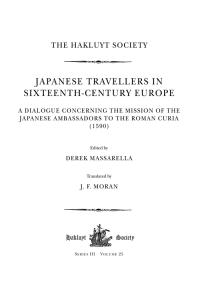Product desciption
Japanese Travellers In Sixteenthcentury Europe Duarte De Sande by Duarte De Sande 9781908145031, 190814503X instant download after payment.
In 1582 Alessandro Valignano, the Visitor to the Jesuit mission in the East Indies, sent four Japanese boys, two of whom represented important Christian daimyo in western Japan, to Europe. This book is an account of their travels. The boys left Japan on 20 February 1582 and disembarked in Lisbon on 11 August 1584. They then travelled through Portugal, Spain and Italy as far as Rome, the highpoint of their journey, before returning to Lisbon to begin the long voyage home on 13 April 1586. They reached Nagasaki on 21 July 1590, amidst great rejoicing, more than eight years after their departure. During their travels in Europe they had audiences and less formal meetings with Philip II, king of Spain and Portugal, and with popes Gregory XIII and Sixtus V, and were received by many of the most important political, ecclesiastical and social figures in the places they visited. Until the arrival of the embassy in Europe, the Euro-Japanese encounter had been almost exclusively one way: Europeans going to Japan. The embassy was an integral part of Valignano's strategy for advancing the Jesuit mission in Japan. The boys chosen were intended to personify Jesuit success in Japan, raise awareness of Japan in Europe amongst the clerical and secular elites, and demonstrate conclusively that what the Jesuits had been writing about Japan since their arrival there in 1549 was not a fabrication. The embassy was further intended to impress upon the boys the glory, unity, stability and splendour of Christian Europe, so that they might report favourably about their experiences on their return, and counter what Valignano believed were the negative impressions of Europe left by Portuguese merchants and seamen in Japan. As part of this plan, a book consisting of thirty-four colloquia detailing the boys' travels was compiled and translated into Latin under Valignano's supervision. It was published in Macao in 1590 with the title De Missione Legatorvm Iaponensium ad Romanum curiam. Valignano anticipated that it would become a standard text in Jesuit seminaries in Japan. The present edition is the first complete version of this rich, complex and impressive work to appear in English, and is accompanied with maps and illustrations of the mission, and an introduction discussing its context and the subsequent reception of the book.


